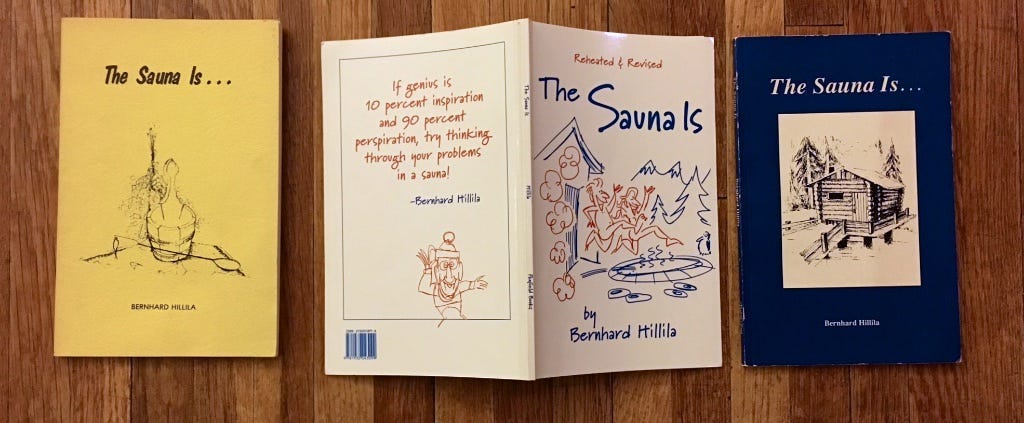The Sauna Is …
book review
“The sauna was not built for saving time but for spending it well.” — Bernhard Hillila
Bernhard Hillila was a pastor, a poet, an educator, and a slackliner…and he was also a Finn. And like any good Finn, he was devoted to the sauna. It is this devotion and knowledge which he shares in his book The Sauna Is. In its pages Hillila seeks to show the non-Finnish world what traditional sauna is, and is not, helping us “unlearn misinformation about the sauna” while providing an overview of its elements, benefits, and history.
In The Sauna Is, Bernhard thoroughly communicates the essential cultural aspects of sauna, correcting some common “mistranslations” while emphasizing its core essence. Some of the most common missteps he corrects, are the portrayal of sauna as either a product to be sold, a health treatment to be endured, or an avenue of promiscuity. These misinterpretations are as much in need of correction today as they were when the book was first published in 1979. When sauna is productized, it often loses its primary benefits and rich cultural texture.
“With the American penchant for merchandising there is, however, a danger that in our land the concept of sauna will be stretched badly out of shape to include sauna belts, sauna facial masks, sauna tubs, sauna cabinets, sauna tents, and steam rooms of all kinds! If the product involves heat, the ad man gets a sudden perspiration and says, “Let’s call it sauna! That’s an ‘in’ term.” Such “saunas” lose something in the translation. The term “sauna” is properly applied only to baths in which the entire body receives dry heat and steam. It is to be hoped that the rapid spread and increased popularity will not lead to a changed, misdirected pattern.”
When adopting foreign practices, we tend to miss the subtle nuance. We hear what we want to hear and latch on to the familiar. And as popularity grows, marketing companies further simplify the “product”. Today, it’s much easier to sell an infrared heat therapy box as “sauna” than to promote the more culturally complete picture Hillila describes.
“The ideal sauna is a small building made of logs, set near a lakeshore, facing toward the sunset.”
“The acme of the sauna experience is achieved when the snow is replaced by a dip into a lake and when one can sit outside in the altogether, dried by unpolluted breezes.”
“In keeping with the sauna mystique, the style of the construction should be simple rustic, rather than fancy, chrome-plated.”
That’s much more difficult to sell…but slick marketing isn’t the only problem. The most egregious of American mistranslations perceives the sauna as sexual, which isn’t surprising in our hypersexualised society. We view the traditional nakedness of Finnish sauna as either shamefully embarrassing or lewd and erotic.
“While sauna bath by definition should be a sensual experience, it doesn’t follow that it should be a sexual one.”
“In sauna, however, nudity is not the objective; it is merely a necessary condition for bathing properly. Supporters of the sauna are not nudists.”
“To make the cleanest possible place something sleazy, tawdry, pornographic is unforgivable.”
Despite these pervasive misinterpretations (and others), true sauna is still enjoyed by millions in Finland and by those of Finnish heritage concentrated in Northern Minnesota, Wisconsin, Michigan, and parts of Canada. There are also a few of us non-Finns who have respectfully and attentively adopted this foreign practice, delighting in its wonderful benefits.
In this review, I have included several quotes from the author, providing a taste of his concise yet descriptive communication style, which makes The Sauna Is a recommended first read for new converts to authentic Finnish sauna.
a note about the 2003 edition:
The version of the book reviewed here was generously provided by the publisher. It bears the tagline “reheated and revised”, which refers to the addition of a short essay by the the author’s granddaughter and new cover art drawn by a political cartoonist-who is a relative of Hillila’s. Having purchased the first two editions of the book (1979, 1988), I would recommend them over this new printing (2003). As an author, Bernhard has a healthy sense of humor, penning books with titles like Finn Fun and its sequel The Finnish Line: More FinnFun. These works probably influenced the publisher to treat The Sauna Is in a similar, comedic fashion (artwork, quotes). After reading the book and examining the the two previous versions, I don’t believe it was author’s intent for this to be Finn Fun: The Sauna Edition. This “rebranding” makes the new version feel a bit weird.


